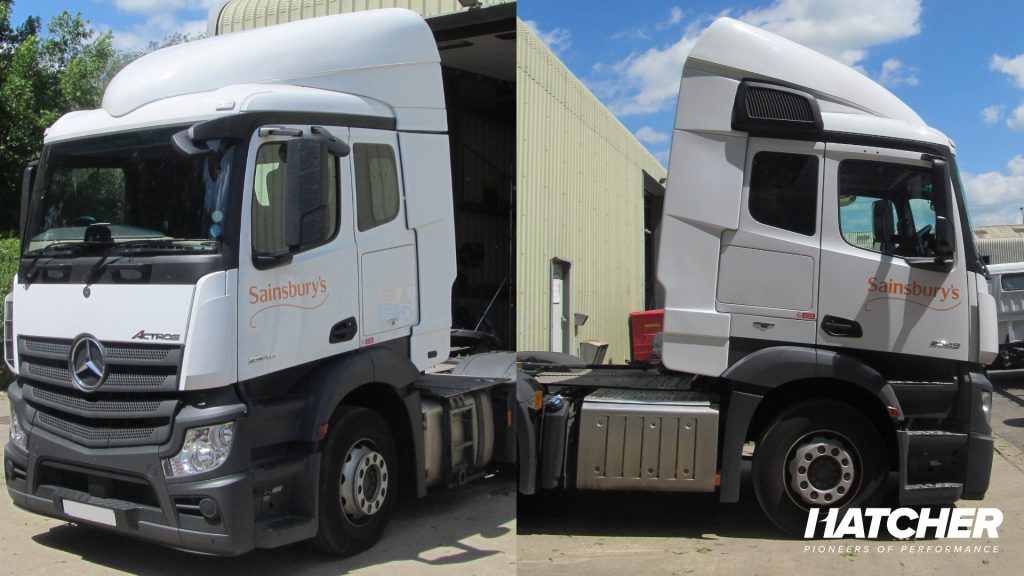
Aero Innovation Milestone Reached
Our 12,000th Freddie air kit management system has just rolled off the production line.
Freddie is probably the benchmark in roof spoiler technology. Designed with the aid of Cranfield University and Mercedes Benz using Computational Fluid Dynamic Modelling (CFD), not only does it push air over and above the trailer but also around it.
The importance of that at first might not be apparent but as Cranfield’s Kevin Garry points out many trunk routes run south to north but the UK’s prevailing wind is usually in a south/south-west to north-west direction.
The technical term is yaw angle – that’s the direction of sidewind against a vehicle. Research has shown this typically to be 6 degrees.
At just 6% the question has to be asked is it worth worrying about? Well depending on trailer and weight yes it can be, reducing sidewind drag in some cases being worth a 2% fuel saving.
Met office researchers do suggest that the UK is experiencing more wind days and that wind speeds are increasing. But data capture in this area only started in the late 1950s and at just a few sites. The Met Office needs more data before they can make a definitive conclusion.
But this is likely. UK Climate Projections (UKCP) models project an increase in near-surface wind speeds over the UK for the second half of the 21st century. Of course, models are a projection and can be fallible but before the end of February the UK has already experienced storms Malik, Corrie, Dudley and Eunice.
Sales manager Craig Poacher says a vehicle travelling at 50 mph down the A1 with a sidewind of 40 mph is experiencing a yaw angle of 12 degrees. “It is 200 miles from Newcastle to Peterborough, and that sidewind could easily lose you a fair few litres of fuel.”
The Freddie air management system is available for numerous models with the latest being the new Mercedes Actros, Scania CG20N and MAN’s TGL/M and TN.
Craig says the Freddie system isn’t just for fully loaded artics trunking south to north and back. Research and customer trials have shown fuel savings for vehicles on more urban routes. This can be as high as 5% for a truck of 42 TGW, even for those with urban routings. “For a 12tonne truck doing 50,000 miles a year, the payback could be less than 10 months,” he notes.
He also thinks it is an extremely smart looking piece of kit. “With its curved lines and soft edges, it compliments what manufacturers are doing with vehicle design. It looks like it has come from the factory.”
What Is Computational Fluid Dynamic Modelling (CFD)
Simply it is a better way of measuring air movement over and around a vehicle and the performance of aerodynamic aids.
The problem with wind tunnel tests is that the wind direction is head on, making it impossible to calculate sidewind Drag and air kit performance. Models can be used for wind tunnel tests, which can be moved around to reflect changes in direction but it doesn’t accommodate subtle changes in wind speed or direction.
CFD is a branch of fluid mechanics that evaluates the movement of liquids or gasses over a surface using high powered computers. The benefit is that weather data can be programmed to represent UK driving conditions. “Windspeed and direction is never constant. That cannot be fully replicated in wind tunnel tests,” adds Craig.
Hatcher Historic Milestones
The Freddie is just one in a long list of Hatcher milestones. We pioneered truck aerodynamics in the 60s with the first roof spoilers with the launch of our Foden S34 air kit. Since then, Hatcher has grown to become the leader in truck and LCV aerodynamics and cab conversions:
- 1968 – Launch of illuminated signboards
- 1970 – First 2D aerodynamic spoiler unveiled for Renault Saviem S series
- 1982 – Night Cap. The original HGV sleeper pod launched
- 2002 – LF Sky Class range introduced
- 2004 – DeepSleeper LCV sleeper conversion launched
- 2005 – Novel 3 In 1 LCV bunk and sliding bulkhead developed
- 2006 – Working with Mercedes Benz and Cranfield University 3D Actros FREDDIE goes into production
- 2009 – Electronic adjustment air kits successfully trialled at Cranfield University
- 2012 – Proximity sensors developed and fully automated SmartSpoiler launched
- 2017 – Development of Shuteye van system
- 2018 – Modified microwave wiring loom incorporating accessible cut off switch
- 2019 – New lightweight honeycomb GRP developed
